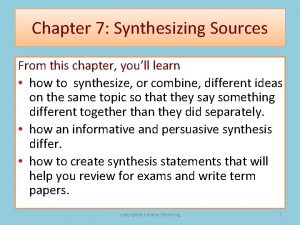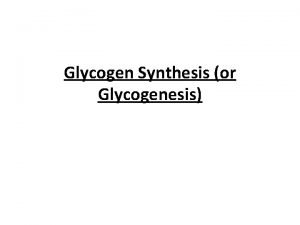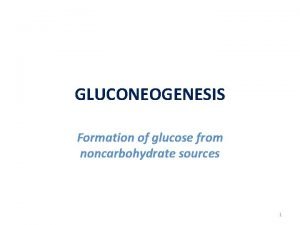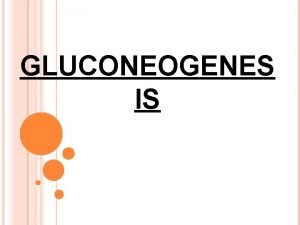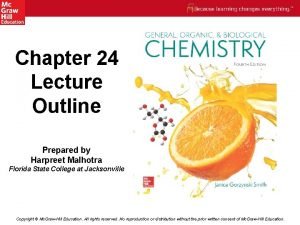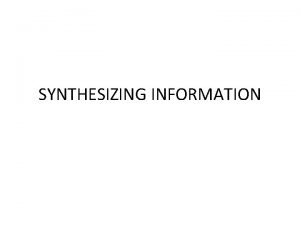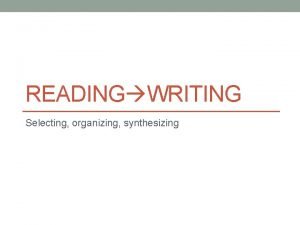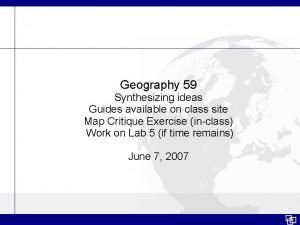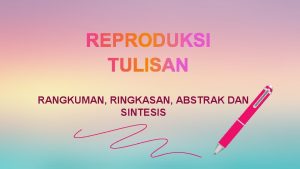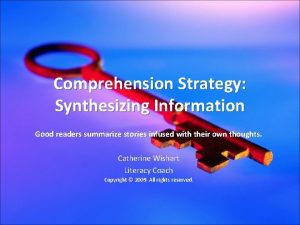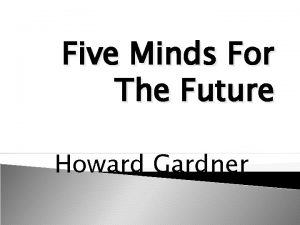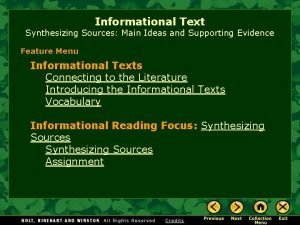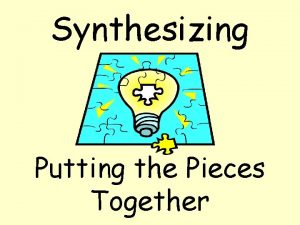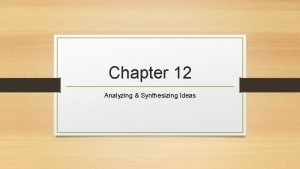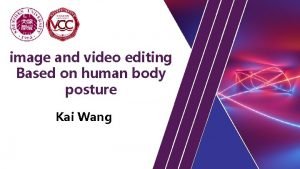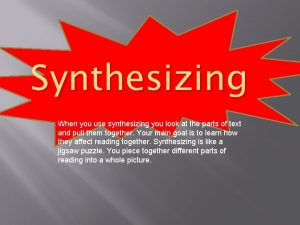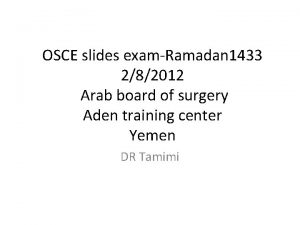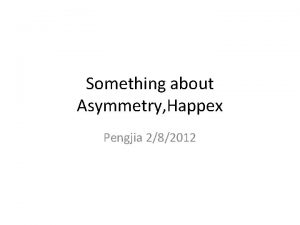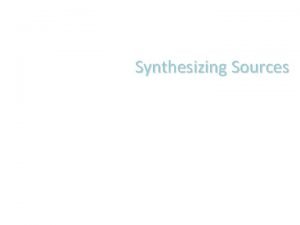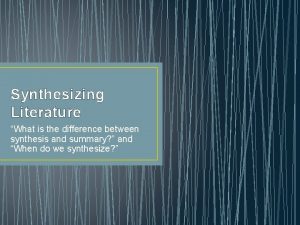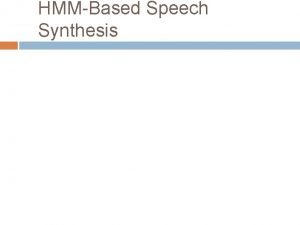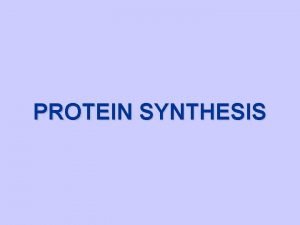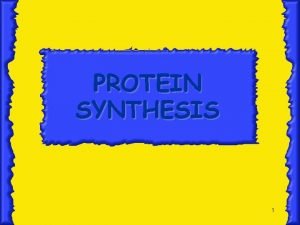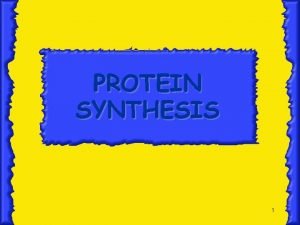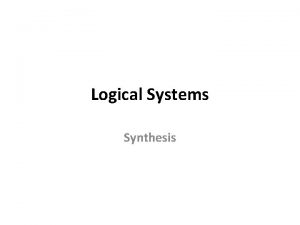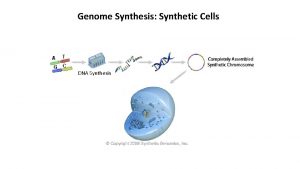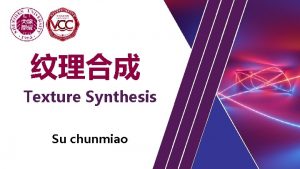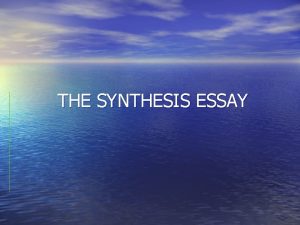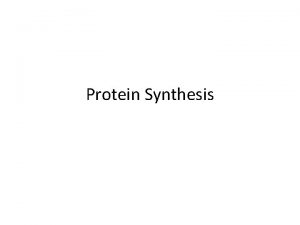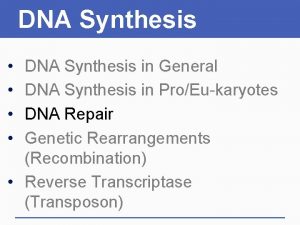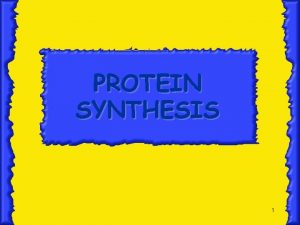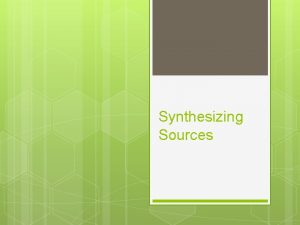Synthesizing Sources 282012 For Today What is synthesis



























- Slides: 27

Synthesizing Sources 2/8/2012

For Today: What is synthesis? Small group discussion of the class preparation Brief Assignment 3 Preparation for Next Class (participation assignment) Brief Assignment 4 Topics for Draft 1. 1

Announcements: 1. 2. 3. 4. Grade appeals ILL Technology issues must be solved by Monday I will return BA 3 preparation assignments and topic proposals in class next week, so be sure to take notes on a separate sheet of paper

What is synthesis? :

What is synthesis? : “Any piece of writing that integrates material from several sources is a Synthesis. ” “An explanatory synthesis (whether essay or paragraph length) defines and explains concepts or processes to help readers see relationships and understand ideas. ”

What is a the purpose of synthesizing? :

What is a the purpose of synthesizing? : “Synthesis allows writers to explore relationships among ideas and to arrange those ideas in a logical and meaningful way. ” “The purpose of an explanatory synthesis is to inform, conveying factual information as accurately as possible. ”

QUESTIONS FOR MAKING CONNECTIONS BETWEEN AND AMONG SOURCES: What positions do the sources take on the issue? How do the sources agree? How do the sources disagree? What evidence do the sources use to support their assertions? How do the sources address opposing points of How do the sources organize their main ideas? view?

What synthesis is NOT: Stacking information from different sources, without establishing their relationship. Example: Chocolate comes to us from South America, where it was once consumed as a bitter, hot beverage, according to Joe Schmoe, author of “Ahh! Chocolate” (12). Ima Goodbar points out that Queen Isabella had an elaborate hot chocolate set that she used on important state occasions (276). Does this happen in your prep assignment?

What synthesis is NOT: Random synthesis words thrown in for good measure. Example: One reason chocolate should be on every elementary school lunch menu is that it makes students feel so good. Rita Dove, president of the Dove Chocolate Corporation, agrees, stating, “Chocolate is the perfect end to a satisfying luncheon” (qtd. in Craigo 18). Does this happen in your prep assignment?

What synthesis is NOT: False relationships between sources. Example: Perhaps the biggest reason taxpayers should be given a standard chocolate deduction is the importance that it has to our entire economy. Nicole Kidman, author of “If I Ate Anything, It Would Be Chocolate, ” writes, “So much in our society is dependent upon our ability to attain chocolate, whether this is through cocoa powder, mocha lattes, or a Cadbury Cream Egg” (42). But in his article “Chocolate Tastes As Good As Halle Berry’s Tonsils, ” Adrien Brody disagrees. He states, “Chocolate is important to American life, but I like vanilla, too” (67). Does this happen in your prep assignment?

Words that indicate synthesis: Words that indicate synthesis show relationships between sources, like these: agrees disagrees goes even further elaborates on clarifies What are some words that indicate synthesis in your prep assignments?

How might we synthesize these? : Topic XYZ Paper 1 A is awesome B is a bad choice C is a bad choice D is awesome Paper 5 B is awesome D is awesome Paper 2 A is a bad choice B is awesome C is a bad choice Paper 6 A is a bad choice D is awesome Paper 3 Paper 4 A is a bad choice B is a bad choice D is awesome B is awesome C is a bad choice D is awesome E No research Paper 7 Paper 8 A is a bad choice C is a bad choice D is awesome

How might we synthesize these? : Topic XYZ Paper 1 A is awesome B is a bad choice C is a bad choice D is awesome Paper 2 A is a bad choice B is awesome C is a bad choice Paper 3 A is a bad choice B is a bad choice D is awesome

Paper 1 Papers 1 and 3 Pape r 3 Papers 1 and 2 Papers 1, 2 and 3 Papers 2 and 3 Pape r 2

Results: While Papers 2 and 3 agree that A is a bad choice, Paper 1 argues that A is awesome. Paper 2 suggests that B is awesome, whereas Papers 1 and 3 disagree, arguing that B is a bad choice. Papers 2 and 3 also agree that D is awesome, which Paper 1 does not address. Papers 1 and 2 agree that C is a bad choice. TOPIC SENTENCE: Papers 1, 2 and 3 each address topic XYZ, in particular, options A, B, C and D.

How might we synthesize these? : Paper 1 A is awesome B is a bad choice C is a bad choice D is awesome Paper 5 A is awesome D is awesome Paper 2 A is a bad choice B is awesome C is a bad choice Paper 6 A is a bad choice D is awesome Paper 3 Paper 4 A is a bad choice B is a bad choice D is awesome B is awesome C is a bad choice D is awesome E No research Paper 7 Paper 8 B is awesome C is a bad choice A is a bad choice C is a bad choice D is awesome What are the common themes and ideas? What are things these authors agree and disagree about? Create a working thesis statement based on one common theme or idea that runs through all the articles. There will be several possible common themes or ideas for you to choose from. Pick the one that you can develop in the most detail.

Papers in which Options are Described as Awesome Option A B Paper(s) 1, 5 2, 4, 7 C D 1, 3, 4, 5, 6, 8 • Most of the papers (with the exception of 2 and 7) agree that D is awesome. • 1 and 5 agree that A is awesome • 2, 4 and 7 agree that B is awesome • Though 2 and 7 do not advocate D, they do not describe D as being a bad choice. Rather, D is excluded from these papers. THEREFORE: Most of the included scholarship suggest that D is awesome.

Small Group Work: Pull out your Class Preparation: Participation Assignment. Get into groups of 2 or 3 Exchange § § Read your classmate’s paper (5 minutes) As a group discuss the following questions (10 minutes): à à § papers Does your classmate’s paper synthesize three reviews? à If not, then what is it doing? What is the most important thing your classmate should know that you noticed on their class preparation assignment? I will be collecting your Preparation Assignments, so you should take notes on a separate sheet of paper to use on your Brief Assignment

Brief Assignment 3: Synthesizing Sources Purpose: To demonstrate your ability to synthesize source material. A mistake many students make on this assignment is summarizing the content of each article in its own paragraph. More than one source should be analyzed in each paragraph. You will want to identify a common theme or idea that you see running through all of the articles and focus on how each article develops or contributes to theme.

Brief Assignment 3: "Virtual Friendship and the New Narcissism” (Christine Rosen) pp. 321 -328 “Virtually Trustworthy” (Judith Donath) pp. 329 -331 “Thx for the IView! I Wud ? 2 Work 4 U!! ; " (Sara E. Needleman)pp. 342345 400 – 600 word ESSAY (intro, thesis, body, conclusion) § Your synthesis should: à à Identify a common theme or idea that you see running through all of the articles. Focus on how each article develops or contributes to theme. Have a thesis statement based on one common theme or idea that runs through all three articles. Describe the common theme, explain how each author develops the common theme, and then explain how each article relates to the others. What are their similarities and differences? Why are these similarities and differences important to theme which you are examining?

Brief Assignment 3: You MUST use proper in-text citations. We are REQUIRING a works cited on BA 3. Chapter 16 in the St. Martin’s e-handbook has the information for in-text citation and works cited entries. Here is the works cited entry format for works from your textbook: Power, Carla. "Not the Queen's English. " First Year Writing: Writing in the Disciplines. " New York: Pearson Custom Publishing, 2011. 371 -375. Print.

Grading: C 1—Issue Identification and Focus Does the student focus on a common theme or idea that runs through each article? C 2—Context and Assumptions Does the student show an awareness of the context in which the source was written? C 3—Sources and Evidence Does the student thoroughly explore the relationship/connection between the articles? Does the student use MLA format correctly?

Grading: C 5—Own Perspective Is the student’s own voice apparent or does the student just summarize the viewpoints of the authors? C 6—Conclusion Does the conclusion effectively pull the analysis together? C 7—Communication Is the essay organized effectively? How effective is the student’s writing at the sentence level?

For Next Class: Reading Class 4 – on the syllabus Preparation: Participation Assignment Due in class on 2/15 (Wednesday) BA 4 is an annotated bibliography. You are going to find the articles that you may end up using on your BA 4. Your preparation assignment will take longer than the last two, so start early! Print and bring the pages from this section from the e -handbook with you: 14 c, 6 th ed – 12 c, 7 th ed

Brief Assignment 4: Annotated Bibliography There is an example of what an annotated bibliography looks like on pages 596 -598 of your First. Year Writing textbook. This assignment helps you prepare for Draft 1. 1 by getting you to critically read annotate the research that you will be synthesizing on the literature review.

Topic for Draft 1. 1: On a separate sheet of paper, please answer the following questions. I will collect and return it WITH FEEDBACK next week in class. 1. 2. 3. If What is your major? What is the tentative topic of your literature review? If you find that your topic is too broad (which is likely), how can you narrow the topic focus of your literature review? you begin research and discover that you cannot find scholarly journal articles (that are less than 1 o yrs old) then you will probably have to think of a different topic.
 Synthesizing sources
Synthesizing sources Glycogen metabolism
Glycogen metabolism Non carbohydrate sources of glucose
Non carbohydrate sources of glucose Gluconeogenes
Gluconeogenes Glucose synthesis from non-carbohydrate sources
Glucose synthesis from non-carbohydrate sources Print sources and web sources
Print sources and web sources Importance of water management
Importance of water management Synthesizing information
Synthesizing information Race writing method
Race writing method Synthesizing ideas in an informational text
Synthesizing ideas in an informational text Apa yang dimaksud rangkuman
Apa yang dimaksud rangkuman Reading strategy synthesizing
Reading strategy synthesizing The disciplined mind example
The disciplined mind example Synthesizing ideas in an informational text
Synthesizing ideas in an informational text Putting the puzzle together main idea
Putting the puzzle together main idea Synthesizing texts
Synthesizing texts Analyzing and synthesizing
Analyzing and synthesizing Synthesizing images of humans in unseen poses
Synthesizing images of humans in unseen poses Meeting objective
Meeting objective Fingerprint galton details
Fingerprint galton details For todays meeting
For todays meeting Today's lesson or today lesson
Today's lesson or today lesson Today class or today's class
Today class or today's class Example of repitition
Example of repitition Vad står k.r.å.k.a.n för
Vad står k.r.å.k.a.n för Underlag för särskild löneskatt på pensionskostnader
Underlag för särskild löneskatt på pensionskostnader Toppslätskivling dos
Toppslätskivling dos Redogör för vad psykologi är
Redogör för vad psykologi är
